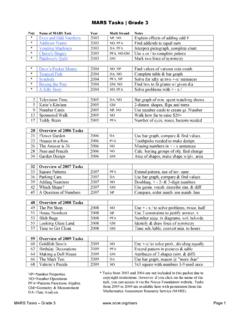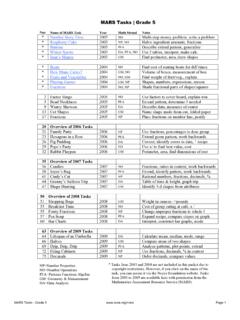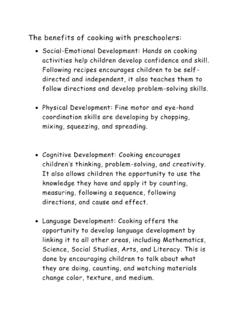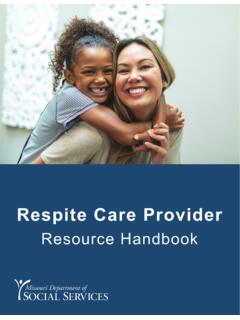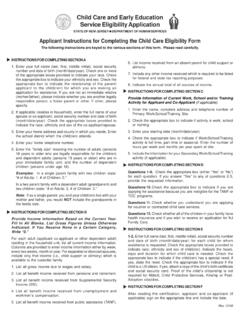Transcription of Based on the author’s work with Louise Derman-Sparks in ...
1 The Many Kinds of Family Structures in Our Communities Julie Olsen Edwards Based on the author s work with Louise Derman-Sparks in Anti-bias Education for Children and Ourselves NAEYC 2009 Children grow up in many different structures of families, and, at different times in their lives, their family structure may change. For young children, the family in which they live is the normal family. It is when children enter group programs outside of their homes that they discover that there are many kinds of families and that the important adults in those programs may or may not think of the child s family as normal or acceptable.
2 One of the most important tasks for early childhood educators is to treat each child s family with respect and help each child feel proud and strong about their family. It is important to learn about the many structures of families and to realize that different families may have quite different issues, needs, strengths and values. The following terms may help you to think carefully and respectfully about each family. These terms are not exclusive - several terms may apply to any family at the same time. It is important to find out right away which term/s each family uses to name itself, and to use the terms that the family chooses.
3 Adoptive family: A family where one or more of the children has been adopted. Any structure of family may also be an adoptive family. Sometimes children (as well as adults) use the term real parents instead of birth parents . Be clear that the adoptive parents are the real parents because they are raising the child. Intervene if other children tease an adopted child with comments such as That isn t your real mommy . Do not automatically assume that any problems a child may be having are due to adoption. Bi-racial or multi-racial family: A family where the parents are members of different racial identity groups.
4 Trans-racial adoptive family: A family where the adopted child is of a different racial identity group than the parents. Children in these families are not half and half , nor do they have to chose one identity over another. Each child is fully who they are. Find out what terms the family uses to describe their various racial identities. As racial identity remains one of the most contentious and difficult issues in the United States, be prepared to listen especially carefully and respectfully to what the family believes and what they want their child to value about her/his identity. Blended family: A family that consists of members from two (or more) previous families.
5 Families may use a variety of terms for the various family members (Step Dad, Gary, Poppop, etc.) and have varying connections with extended family members. Encourage children to show all of their family in drawings and to make gifts for everyone (if you do that kind of activity). Be clear that all family members are real and that all the relationships are important to the child. Broken home : A highly derogatory term used to describe the homes of children from divorced families. Very hurtful. Be clear that there is no such thing as a broken family. Each family form is what it is and is a family! Co-custody family: An arrangement where divorced parents both have legal responsibility for their children.
6 Children may alternatively live with both parents or live with one and have regular visitation with the other. Find out right away which parent is responsible for the child on what days, who picks up child, etc. Encourage children to acknowledge both homes do not ask them to choose. Conditionally separated families: A family member is separated from the rest of the family. This may be due to employment far away; military service; incarceration; hospitalization. They remain significant members of the family. Support the child to deal with a difficult emotional time. You can help the child to stay connected by making drawings, dictating letters or stories about favorite activities at school, taking photos doing a favorite activity, creating a special calendar that marks off the days until the family will be reunited.
7 Extended family: A family where Grandparents or Aunts and Uncles play major roles in the children s upbringing. This may or may not include those relatives living with the children. These family members may be in addition to the child s parents or instead of the child s parents. Be sure to include in school invitations/conferences all the people in an extended family who play major socialization roles. Intervene if others deny the central role of these relatives, for example if a child says Mama puts you to bed not your Auntie! Foster family: A family where one or more of the children is legally a temporary member of the household.
8 This temporary period may be as short as a few days or as long as the child s entire childhood. kinship care families are foster families where there is a legal arrangement for the child to be cared for by relatives of one of the parents. Use whatever terminology the child uses about their foster parents (they may call them Mom or Dad or they may use their first names or may call them Mama 2 and Papa 2, etc). Check with the foster parents about what they have told the child about the absent family and the likelihood of reuniting. If the original parents are able to visit, and wish to come to the school, make them welcome.
9 Never ask a child to chose who is most important to them. Gay or Lesbian family: A family where one or both of the parents sexual orientation is gay or lesbian. This may be a two-parent family, an adoptive family, a single parent family or an extended family. In many parts of the United States these families may not be allowed full legal rights to their children, and in most parts of the country they face significant social prejudice. It is up to the Early Childhood professionals to prove that they are open and safe to talk with. No one but the members of the family has the right to out a family (reveal their sexual orientation) to anyone else.
10 Find out what terms the child uses to describe her/his parents (Daddy & Pops, Mama Jan & Mama Lisa?). Be sure that all letters, forms, invitations uses language that makes clear that these families are welcome. Immigrant family: A family where the parents have immigrated to the United States as adults. Their children may or may not be immigrants. Some family members may continue to live in the country of origin, but still be significant figures in the life of the child. (Also see Trans-national families below.) Each of these families brings with them a set of culturally Based behaviors for raising their precious children. And each of these families is continually navigating between what made sense in their country of origin, and what is needed in their new country.




